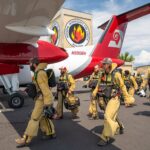
By Daniel Reaves | Field Correspondent, SmokeJumper.net
When the alarm sounds, there’s no runway, no hesitation, and no second chance. For the nation’s elite smokejumpers, the fire line begins thousands of feet above the forest floor.
Born in the 1930s out of necessity and courage, smokejumping remains one of the most daring and specialized forms of wildland firefighting. These men and women parachute into remote, rugged terrain — often miles from the nearest road — to stop fires before they explode into full-scale disasters.
But the modern smokejumper is more than a firefighter. Today’s teams blend aerial operations, survival expertise, and fire science into a discipline that demands physical endurance and mental precision in equal measure.
“We’re the tip of the spear,” says Captain Laura McKenzie, a veteran smokejumper based in Redding, California. “Our job isn’t to watch a fire — it’s to get there first, contain it fast, and protect what can’t be replaced.”
Each jump begins long before takeoff. Crews study wind patterns, fuel loads, and terrain data in real time, guided by mission planners and pilots who operate modified aircraft like the Twin Otter, Sherpa C-23B, and C-130A. Once over the drop zone, jumpers exit in rapid succession, steering steerable round parachutes toward clearings barely wider than a suburban driveway.
Once on the ground, the real work begins. Armed with chainsaws, pulaskis, and shovels — along with packs that can weigh over 100 pounds — jumpers establish firelines, cut escape routes, and build control zones, often working for days in isolation before extraction.
While the spirit of the job remains unchanged, technology is reshaping how smokejumpers operate. Real-time mapping, portable communications, and drone reconnaissance now support jump missions that used to rely purely on instinct and luck. Enhanced personal protective gear and lighter fire shelters have improved survivability in high-risk situations.
Still, for all the advances, veterans insist the profession’s essence is timeless. “No matter how advanced we get,” says McKenzie, “it still comes down to courage, teamwork, and the willingness to step out that door.”
As wildfires intensify across the American West, the demand for smokejumpers continues to grow. From Alaska’s boreal forests to California’s canyonlands, these airborne firefighters remain the country’s first line of defense against an increasingly volatile wildfire landscape — living proof that bravery doesn’t just walk into the fire. Sometimes, it jumps.






